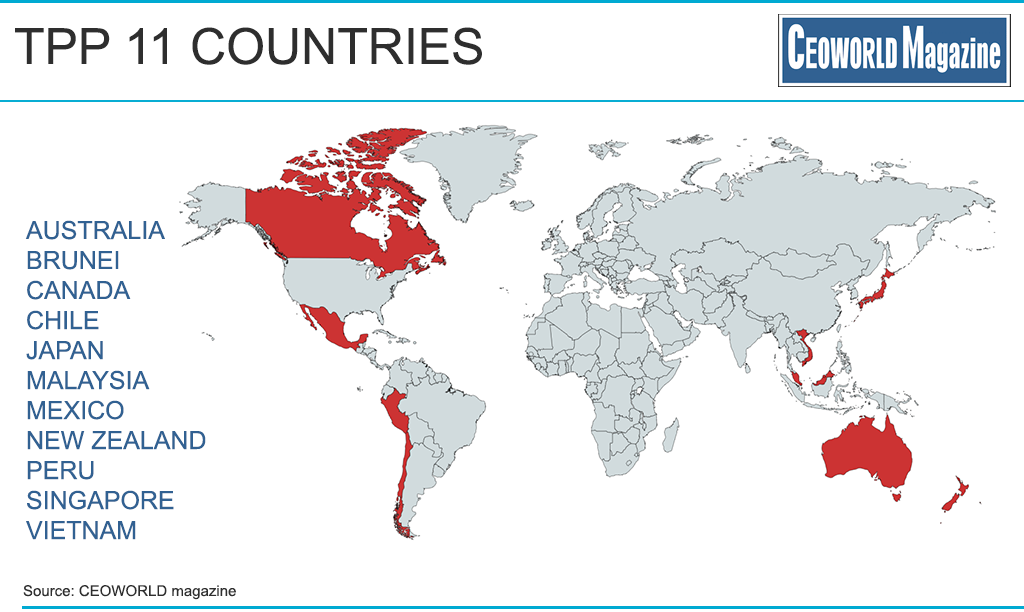Prepare your business: TPP11 is coming!

What is TPP11?
TPP11 (also known as CPTPP or TPP) is the Comprehensive and Progressive Agreement for Trans-Pacific Partnership. It is coming soon with 11 members:
Australia, Brunei, Canada, Chile, Japan, Malaysia, Mexico, New Zealand, Peru, Singapore, and Vietnam.
This is poised to be the most important trade agreement in more than two decades.
TPP11 is likely to come into effect by late 2018 or 1 January 2019.
What can we expect from TPP11?
The agreement covers about 490 million people and 13% of global GDP, with a per capita income of over US$19,000. Thus, it is expected to integrate the Asia-Pacific markets by reducing barriers to the goods and services trade (it will remove tariffs on an estimated 95% of goods), protecting investments and intellectual property rights, establishing rules for e-commerce, and promoting fair competition.
It is the largest regional free trade agreement in Asia, with more members expected to join in future.
After the withdrawal of the United States, most firms expected the agreement to fade away…
That is why few had made contingency plans for its implementation. Now, the clock is ticking for all members before the agreement takes effect.
When leaders from 11 TPP countries announced their intention to move forward with the trade agreement, most businesses were caught off guard.
Most of TPP11 is identical to what was negotiated originally. Some commitments have been ‘suspended’ for now, but the initial deal largely remains intact.
Will all firms benefit from TPP?
The final result will be a much more dynamic, integrated, and competitive region with benefits being limited to TPP member firms.
Non-TPP member firms (including, as of now, many American importers and exporters) will not have access to these preferential benefits.
However, some provisions will ‘spill over’ to non-members. For example, better protections for intellectual property are likely to benefit all firms and not just TPP firms. Non-member firms may be able to take advantage of some provisions, if they are clever, careful, and have good specialist help.
Is TPP good news for exporters?
Duties are likely to be completely eliminated for a significant percentage of goods from the very first day of the agreement becoming effective. For most of the remaining sensitive products, duties will be reduced over time.
This is good news for exporters who currently face substantial duties in some markets.
Some examples:
In ICT: Duties for more than 200 new categories are expected to be eliminated, provided the origin criteria are met by TPP members. Every single part and component in electronics will also be tariff-free.
In agriculture: Beef imported into Japan currently faces duties of 38.5%. This will be lowered to 9%. Dairy products into Canada can face duties as high as 250%. These are also coming down to ensure greater access. Farmers trying to export poultry products into Mexico struggle to be competitive as they face duties of up to 234%. Many of these tariffs will fall all the way to zero on the first day of the agreement coming into effect. Nearly all other agricultural products become duty-free within three to seven years.
What are the new opportunities in services?
Firms should find it easier to provide services across member countries in areas like banking, insurance, construction, logistics, accounting, travel and tourism, consulting, app and game development, and graphic design.
Trade in services constitutes an increasingly important part of global trade. Services make up as much as 40–80% of the value contained in manufactured goods. They are important catalysts that enable manufacturing and allow SMEs to access critical tools, such as cloud-based digital tools, and e-commerce retail and distribution services.
The TPP includes rules to ensure market access, non-discrimination, and fair competition for services from TPP parties.
For instance:
Concerning business mobility: The TPP includes a chapter on ‘temporary entry’ to facilitate transparency in processes that enable the travel of skilled people between TPP markets for the purpose of doing business.
Have you read?
Ten Benefits of the Comprehensive and Progressive Trans-Pacific Partnership – read here.
Add CEOWORLD magazine to your Google News feed.
Follow CEOWORLD magazine headlines on: Google News, LinkedIn, Twitter, and Facebook.
This report/news/ranking/statistics has been prepared only for general guidance on matters of interest and does not constitute professional advice. You should not act upon the information contained in this publication without obtaining specific professional advice. No representation or warranty (express or implied) is given as to the accuracy or completeness of the information contained in this publication, and, to the extent permitted by law, CEOWORLD magazine does not accept or assume any liability, responsibility or duty of care for any consequences of you or anyone else acting, or refraining to act, in reliance on the information contained in this publication or for any decision based on it.
Copyright 2024 The CEOWORLD magazine. All rights reserved. This material (and any extract from it) must not be copied, redistributed or placed on any website, without CEOWORLD magazine' prior written consent. For media queries, please contact: info@ceoworld.biz
SUBSCRIBE NEWSLETTER









